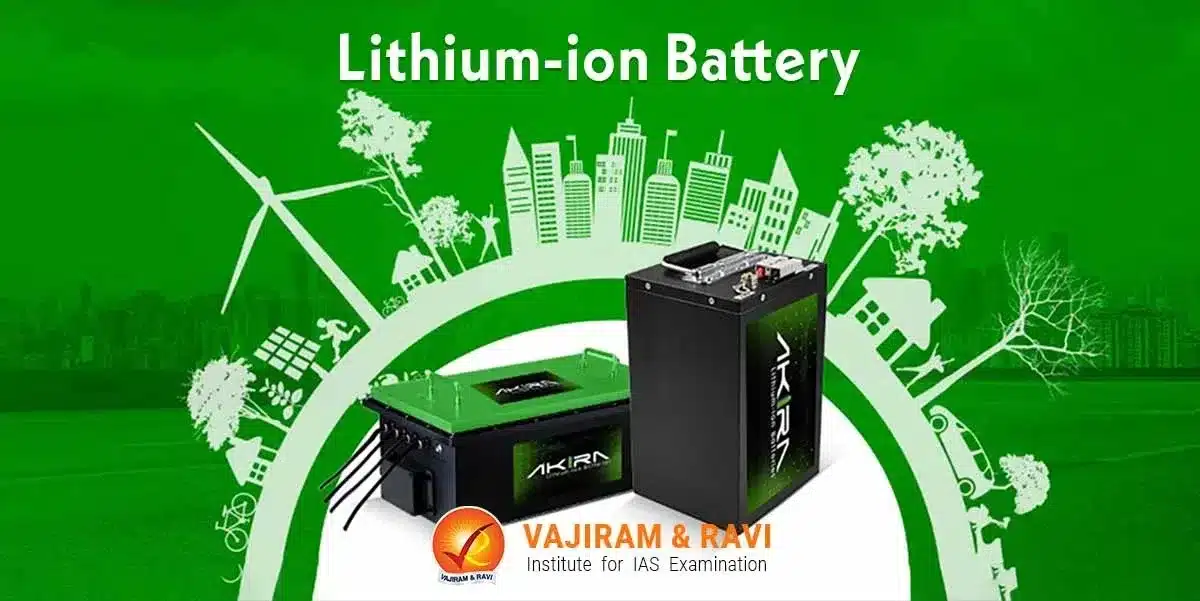A lithium-ion (Li-ion) battery is a type of rechargeable battery that uses lithium ions as the main component of its electrochemical cells. It is characterised by high energy density, fast charge, long cycle life, and wide temperature range operation. Lithium-ion batteries have been credited for revolutionising communications and transportation, enabling the rise of super-slim smartphones and electric cars with a practical range such as portable electronics and electrified transportation.
M. Stanley Whittingham, John B. Goodenough, and Akira Yoshino received the Nobel Prize in Chemistry for their contributions to the development of the modern Li-ion battery in 2019.
Lithium-ion Battery Structure
A lithium-ion battery consists of an anode (negative electrode), cathode (positive electrode), separator, electrolyte, and two current collectors (positive and negative).

- Cathode: The cathode of a lithium-ion battery is typically made of a lithium metal oxide, such as lithium cobalt oxide (LiCoO2), lithium manganese oxide (LiMn2O4), or lithium iron phosphate (LiFePO4).
- The choice of cathode material influences the performance characteristics of the battery.
- Anode: The anode is usually composed of graphite. During discharge, lithium ions move from the anode to the cathode through the electrolyte, and during charging, they move back to the anode.
- Electrolyte: The electrolyte is a conductive medium that allows the flow of lithium ions between the cathode and anode.
- It is typically a lithium salt dissolved in a solvent.
- Separator: The separator is a permeable membrane that keeps the cathode and anode apart to prevent a short circuit while allowing the passage of lithium ions.
- Rechargeability: One of the key advantages of lithium-ion batteries is their rechargeability.
- They can be recharged hundreds to thousands of times, depending on the specific chemistry and use conditions such as overcharging or undercharging.
Working of Lithium-ion Battery
Working principle of Lithium-ion Battery based on electrochemical reaction. Inside a lithium-ion battery, oxidation-reduction (Redox) reactions take place which sustain the charging and discharging cycle.

- Discharging:
- During this cycle, lithium ions form from the ionization of lithium atoms in the anode.
- Oxidation reaction takes place: LiC6 → C6 + Li+ + e-
- The lithium ions move from the anode and pass through the electrolyte until they reach the cathode, where they recombine with their electrons and electrically neutralise.
- The lithium ions are small enough to be able to move through a micro-permeable separator between the anode and cathode.
- Li-ion batteries are capable of having a very high voltage and charge storage per unit mass and unit volume owing to the small size of lithium.
- During this cycle, lithium ions form from the ionization of lithium atoms in the anode.

- Charging cycle:
- During the charging cycle, the process is exactly the opposite of the discharging cycle. The lithium ions return to the anode from the cathode and electrons are transferred from the anode to the cathode.
- Lithium ions flow from the cathode to the anode, and electrons flow from the anode to the cathode, as the battery is charging.
- There is a steady flow of electrons as long as lithium ions are making their way from one electrode to the next.
- Reduction takes place at the cathode –CoO2 + Li+ + e- → LiCoO2 ( Cobalt oxide combines with lithium ions to form lithium-cobalt oxide (LiCoO2).
Lithium-ion Battery Significance
The excellent electrochemical properties of lithium such as highly reactive properties give Lithium the potential for high-density batteries, enhanced standby power, complacent design, etc.
- High charge density: Since lithium is the most electropositive element, it has a high charge density, and can give a lot of energy without being very heavy. This means they can store a significant amount of energy for their size and weight.
- Electropositivity is a measure of how easily an element can produce positive ions or how easily an element can produce energy.
- Compact design: They can store a large amount of energy in a relatively small and lightweight package.
- Low self-discharge rate: They also exhibit a relatively low self-discharge rate when compared to other rechargeable batteries, allowing them to hold their charge for extended periods.
- High-scale current: Lithium-ion batteries can deliver large amounts of current for high-power applications.
- For example– Lithium-ion battery cells can deliver up to 3.6 Volts, 3 times greater than any present technology.
- No memory effect: Lithium-ion batteries have no memory effect, a detrimental process where repeated partial discharge/charge cycles can cause a battery to ‘remember’ a lower capacity.
- Free-form toxic materials: These batteries do not contain toxic cadmium, which makes them easier to dispose of than Ni-Cd batteries.
- Fossil Fuel-free society: Modern society is completely dependent on fossil fuels, and lithium-ion batteries have great potential to replace the internal combustion engine and store solar energy, and wind energy, which will reduce dependency on fossil fuels by providing sustainable renewable energy.
Lithium-ion Battery Application
The versatility and performance characteristics of lithium-ion batteries make them a preferred choice in a wide range of applications, such as aerospace, electric vehicles, electronics industries, etc.
- Portable electronic devices: Lithium-ion batteries are predominantly used in various portable electronic devices such as smartphones and laptops etc.
- High-end application: It can also be employed to power electrical systems for aerospace applications and submarines.
- For Example, Aircraft-Boeing 787, where weight is a significant cost factor.
- Hybrid electric vehicles: Lithium-ion technology so far has the best option for potential applications in battery-powered vehicles with a practical range thereby reducing dependency on fossil fuels.
- Example- Tesla’s Model S cars are using a P85 battery consisting of 18,650 Li-ion cells, with an energy output of 80-90 kWh.
- Defence: Various submarines are using lithium-ion batteries as a source of power back in emergency and enhanced stealth operation.
- Medical devices: They are used in cardiac pacemakers and other implantable devices.
Lithium-ion Battery Disadvantages
Despite several promising applications of lithium-ion batteries, they have certain limitations:
- Highly Inflammable: The batteries tend to overheat and can face insulation failure at high voltages.
- In some cases, this can lead to thermal runaway and combustion.
- Performance constraints: Lithium-ion batteries face the situation of increased weight and limited performance in some cases due to the requirement of safety mechanisms to limit voltage and internal pressures.
- Low self-life: Lithium-ion batteries are also subject to ageing, meaning that they can lose capacity and frequently fail after some years.
- Heavily dependent on imports: Another factor limiting their widespread adoption is their uneven geographical distribution of lithium leading to higher cost, which is around 40% higher than Ni-Cd.
Lithium-ion Battery UPSC PYQs
Q1: In the context of electric vehicle batteries, consider the following elements: (UPSC PYQs)
- Cobalt
- Graphite
- lithium
- Nickel
How many of the above usually make up battery cathodes?
a) Only one
b) Only two
c) Only three
d) All the four
Ans: (c)
Last updated on July, 2025
→ UPSC Notification 2025 was released on 22nd January 2025.
→ UPSC Prelims Result 2025 is out now for the CSE held on 25 May 2025.
→ UPSC Prelims Question Paper 2025 and Unofficial Prelims Answer Key 2025 are available now.
→ UPSC Calendar 2026 is released on 15th May, 2025.
→ The UPSC Vacancy 2025 were released 1129, out of which 979 were for UPSC CSE and remaining 150 are for UPSC IFoS.
→ UPSC Mains 2025 will be conducted on 22nd August 2025.
→ UPSC Prelims 2026 will be conducted on 24th May, 2026 & UPSC Mains 2026 will be conducted on 21st August 2026.
→ The UPSC Selection Process is of 3 stages-Prelims, Mains and Interview.
→ UPSC Result 2024 is released with latest UPSC Marksheet 2024. Check Now!
→ UPSC Toppers List 2024 is released now. Shakti Dubey is UPSC AIR 1 2024 Topper.
→ Also check Best IAS Coaching in Delhi
Tags: lithium-ion battery quest















